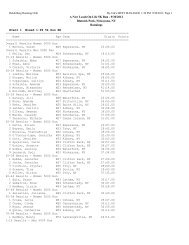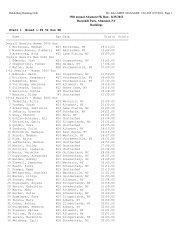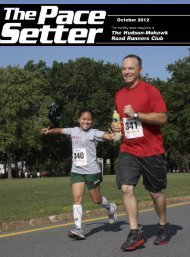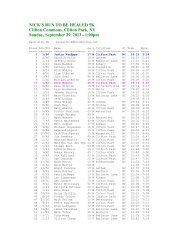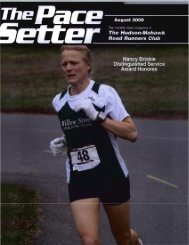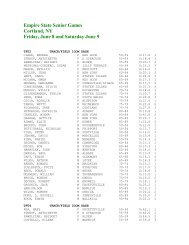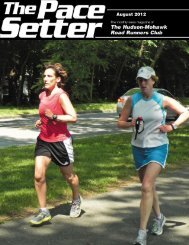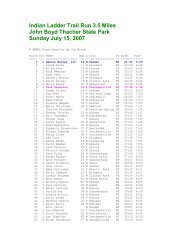October 2011 - Hudson Mohawk Road Runners Club
October 2011 - Hudson Mohawk Road Runners Club
October 2011 - Hudson Mohawk Road Runners Club
You also want an ePaper? Increase the reach of your titles
YUMPU automatically turns print PDFs into web optimized ePapers that Google loves.
The Running Doctor<br />
by Dr. Tim Maggs<br />
The Importance of X-Rays<br />
in the Standing Position<br />
History<br />
The patient is a 15 year old female rower<br />
who has excelled in crew for the past 2 years.<br />
Her severe low back pain began approximately<br />
2 years ago as well. In her first year of crew, the<br />
patient was a “sculler” (one oar in each hand,<br />
seated in middle) and her second year she became<br />
a “sweeper” (one oar in 2 hands, rowing<br />
on one side only). This produces significant<br />
demand on the low back and trunk.<br />
In November, 2010, the patient went to her<br />
orthopedist, who ordered x-rays in the lying<br />
down position. The front to back view (Fig. 1)<br />
and the side view (Fig. 2) are seen here. Upon<br />
viewing the x-rays, Dr. Orthopedist said they<br />
were negative (nothing wrong).<br />
joints, which is very<br />
bad for a 15 year old<br />
girl. Loss of normal<br />
joint mobility is typically<br />
a result of abnormal<br />
joint loading, or<br />
biomechanical imbalances.<br />
Standing x-rays<br />
were taken of the low<br />
back, which allows the<br />
influence of gravity to<br />
be seen. The front to<br />
back view in the standing<br />
position (Fig. 3)<br />
provides a significantly<br />
different impression<br />
than the view that was<br />
taken lying down (Fig.<br />
1). Likewise, the side<br />
view in the standing<br />
position (Fig. 4) gives<br />
a significantly different Fig. 2<br />
impression than the<br />
view that was taken lying down (Fig. 2).<br />
the center of gravity from the side. It’s supposed<br />
to be going through the short vertical<br />
line, but this patient’s weight bearing is in the<br />
back of the spine, with abnormal weight going<br />
through the back of the discs and the nerve<br />
roots (predictably causing disc bulges).<br />
Fig. 1<br />
His recommendation was to rest for 6-8<br />
weeks while getting physical therapy. The patient<br />
went to approximately 8 physical therapy<br />
visits and felt mild improvement. She refrained<br />
from most activity until the spring of <strong>2011</strong>, and<br />
then began crew again. By early April, the<br />
pain was back in full force, and the patient was<br />
again ordered to stop rowing and get an MRI.<br />
The MRI showed 2 disc bulges in the lowest<br />
joints of the spine. At this point, the orthopedist<br />
recommended quitting crew. Unfortunately,<br />
this young girl was one of the better<br />
athletes on the team, and the team had just<br />
gone to the Nationals in 2010. Needless to say,<br />
this recommendation to a 15 year old athlete,<br />
especially with no hope for improvement, is<br />
quite harsh.<br />
Biomechanical Exam<br />
The patient came into our office for a biomechanical<br />
exam on July 22, <strong>2011</strong>. The exam<br />
showed abnormal restriction in multiple key<br />
Fig. 3<br />
Standing X-Ray Findings<br />
In Fig. 3, the vertical line in the center represents<br />
the patient’s center of gravity. We can<br />
see there is a severe misalignment between the<br />
spine and the front of the pelvis. Secondly, the<br />
horizontal lines at the top of the pelvis show<br />
an imbalance between the right and left pelvis,<br />
causing low back, hip, knee and leg length<br />
imbalances. Finally, the arrows point to the obturator<br />
foramen, which actually are the same<br />
size, but appear different due to the abnormal<br />
rotations of the pelvis.<br />
In Fig. 4, the long vertical line represents<br />
Conclusion<br />
The imbalances between right and left<br />
make the vulnerability for low back/pelvic<br />
problems proportionately higher. These imbalances,<br />
coupled with the demands of crew, will<br />
keep this athlete sidelined until she begins the<br />
appropriate rehabilitative care. The first phase<br />
of care consists of therapies and treatment that<br />
will help reduce the disc bulging, spasms and<br />
inflammation that accompany this condition.<br />
Once the symptoms are reduced, a re-education<br />
of the postural muscles and alignment of<br />
the body is needed. This process can take up<br />
to one year; however, if this young girl doesn’t<br />
go through this process, it’s safe to assume her<br />
future will consist of limited physical activity.<br />
Dr. Maggs can be heard on his live internet radio<br />
show, The Structural Management® Hour at his website,<br />
www.StructuralManagement.com on Thursdays<br />
3-4 pm EST. He can also be contacted at RunningDr@aol.com<br />
r<br />
The Pace Setter – 11






